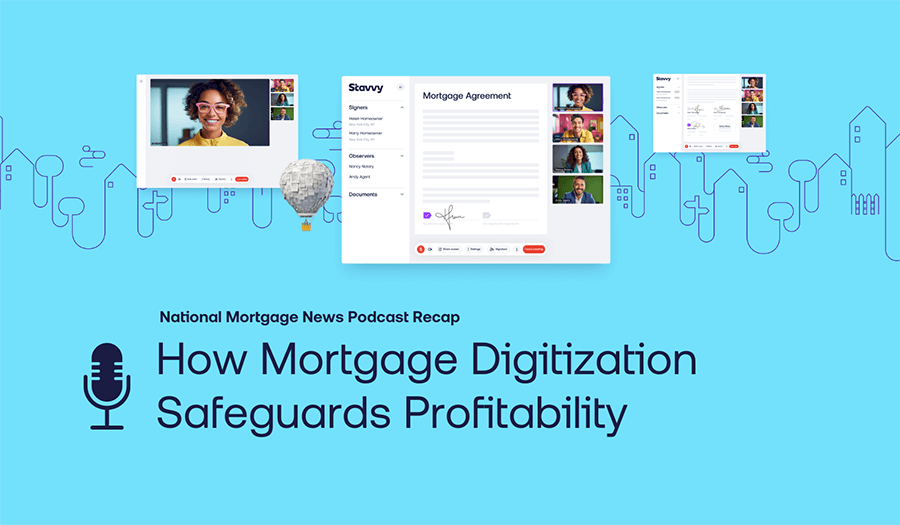Our society is in a constant state of flux. As humans, it is in our DNA to evolve and adjust to different factors in our environment. The COVID-19 pandemic is the perfect example of that. It has changed how we dress (enter the face mask), travel, work, and even socialize.
The business world is no different. Evolution is palpable; technological advancements and consumer preferences coupled with the pandemic drove significant change in 2021 from bubbling curiosities about digital transformation to new tools and entire brand, product, and workflow overhauls. Begging the question, “what’s in store for 2022?"
The future of consumer lending and real estate
As 2021 comes to a close, we’ve been thinking a lot about the progress in the consumer lending and real estate spaces. The loan origination, title & settlement, loan servicing, and business and legal industries are predominantly financial in nature, and therefore, tend to innovate more slowly. However, we have observed some notable changes over the past year and are eager to see what continues to unfold in 2022.
Loan Origination
Improvements in technology and consumer demands have changed the look and feel of loan origination. No one knows that better than our Vice President of Legal & Capital Markets, Jeremy Potter.
In 2021, Jeremy noted that the industry has welcomed some important innovations, including:
- Direct consumer banking imports, such as collecting and calculating income via a customer’s linked checking account helped to streamline the digital mortgage application process.
- 3D scans and video floor plan measurements helped bring efficiencies to the appraisal industry.
- Emerging technologies like blockchain proved successful in originating home equity lines of credit (HELOCs) at scale.
- Digital tools and capabilities became more available for real estate partners, allowing for more real-time preapprovals and greater transparency.
- iBuyers, or real estate companies that buy and sell properties via technology, entered the marketplace fueling the race for the first, all-in-one platform that seamlessly connects the people and processes of real estate buying, mortgage, title, and insurance.
These advancements suggest to us that lenders see and are leveraging the potential of technological solutions and may just be the first steps towards digital transformation. Looking ahead to next year, Jeremy predicts that:
- Homeownership demands will continue to drive fierce competition among lenders, leading to further innovation in more proactive underwriting, preapprovals, and faster verifications to support first-time homebuyers compete in the market.
- The home valuation sector of the industry will likely continue to adopt technology for appraisers and lenders in search of more business efficiencies.
Learn more about Stavvy’s loan origination solutions.
Title & Settlement
When we posed this question to Kosta Ligris, our CEO and co-founder with over 20 years of title agency experience, he too reflected on the influence COVID-19 has had on the industry this year.
Kosta observes that financial institution leaders, including title and settlement agencies, are beginning to see the direct impacts of the pandemic, more specifically, how COVID-19 has affected their core business services, ability to deliver a safe and efficient customer experience, the talent pool, and use of or need for technology. “It’s not just this pandemic—it's a broader awareness of how much we rely on paper and in-person. The industry is starting to recognize how powerful technology can be during storms, emergencies, and other disruptive events—technology closes these gaps.”
Despite the recognition that technology is an integral business tool, title and settlement agencies, like most financial institutions, have been slower to adopt due to, among other concerns, their need to maintain the integrity and security of every financial transaction. The title and settlement industry is moving towards innovation; however, perhaps not as quickly as other sectors given the highly regulated nature of their business. Leaders in the space often await direction and make decisions to align with the financial institutions they serve.
Kosta believes that the title industry has seen the most innovation with hybrid transactions when customers meet with a notary or title and settlement agent in-person to conduct a portion of their transaction.
Adopting fully digital closings with eNotes and remote online notarization (RON) is slowly becoming an acceptable proposition. However, overall, the title industry is slow to change compared to what we're seeing in other lending and real estate sectors.
Kosta attributes the slower adoption rates to “a latency brought on by the industry not knowing how to get all of the stakeholders involved in these transactions in the capital markets, such as warehouse lenders and custodians, and becoming more comfortable with the digital world.” This will be a critical hurdle for the industry to overcome before digital transactions are commonplace. There is a clear prerequisite for tackling the fragmentation between the handoffs of files and artifacts.
Learn more about Stavvy’s title & settlement solutions.
Loan Servicing
Stavvy’s Chief Strategy Officer, Shane Hartzler, also reflects on the impacts COVID-19 has and continues to have on the loan servicing industry.
Recognizing the extent to which COVID-19 has affected the entire mortgage industry, its impact has perhaps been the most pronounced in the loan servicing space. Millions of Americans turned to the option of emergency mortgage forbearance programs that became available during the early days of the COVID pandemic to stay in their homes while they were unable to make their mortgage payments. Use of the forbearance provision peaked in May 2020 at about 7% of all single-family mortgages (about 3.4 million) and gradually declined to 5% by February 2021.
As a result, loan servicers have spent much of the last two years uncertain as to how and when to help homeowners begin transitioning back to making regular mortgage payments. And now, as we reach the beginning of 2022, the last of the mortgage moratoriums are coming to an end and an uptick in loan modifications and other default servicing actions is inevitable.
However, just as COVID forced loan originators and settlement companies to explore technology solutions to provide safe and customer-friendly options, so too, the servicing industry can take advantage of some of the very same technology solutions to help struggling homeowners get back on their feet.
Indeed one of the most significant changes of 2021 (and one that likely went under the radar for many in the industry) was Ginnie Mae’s announcement that loan modifications and partial claims could be signed, notarized, and recorded electronically. This change, and the previous allowances by the government-sponsored enterprises (GSEs) to do the same, provides servicers new opportunities to deliver consumer-friendly services and potentially make back-office operations more efficient.
Servicers using remote online technology solutions no longer need to print and send a loan modification package and hope that the homeowner can find a notary and get every document executed and returned correctly on time. In RON-eligible states, current technology and legislation allow loan servicers to prepare and collect documents for electronic signature and notarization in real-time, whenever and wherever it’s most convenient for the homeowner.
Learn more about Stavvy’s loan servicing solutions.
Business & Legal Services
Consumer expectations for service, convenience, and security grew in 2021 and appear to be heading in that same direction for 2022.
For law firms, real estate companies, and financial advisory firms, the demand for real-time execution is as strong as the need for real-time information. Therefore, it is crucial for lawyers, realtors, and financial advisors, among others, to be able to provide their clients the right technological tools to stay competitive and serve their unique and ever-changing needs.
This year, many consumer-centric, web-based tools and apps have popped up to help navigate a variety of financial and legal transactions, including real estate platforms delivering cash offers on behalf of buyers. It is likely that this trend will continue into the foreseeable future.
Flexibility, responsiveness, and expertise remain the differentiators as legal and financial businesses look to delegate to technology to serve their clients better and stay a leg up on their competitors.
Learn more about Stavvy’s solutions for business & legal services.
Goodbye 2021, Hello 2022
Life has changed dramatically in the past few decades, and then, just again in the last two years, with COVID-19.
Adjusting your organization to fit the new tech-first world will not happen overnight. So, instead of adding a fancy digital tool to your process and hoping for the best, it may be wise to make sure your company is ready for the future, one that is sure to be driven by data, innovation, and technology. The next best step may be to ask yourself the following questions:
- Do we have the right processes in place to take advantage of digital?
- Have we created the right culture to ensure the adoption of digital tools?
- What is our company’s vision for the future, and how does technology play a role?
- If we are considering partnering with a tech vendor, are we confident the vendor takes seriously our obligation to safeguard confidential client and customer consumer information?
Change isn’t easy, although the best things in life rarely are. To truly lead, you must fight the urge to keep things as they are and dare to forge ahead into the “new normal.”
More resources on innovation and digital transformation for 2022:
Digital Transformation in Mortgage Lending [Whitepaper]
Stavvy is Here to Simplify Life’s Defining Moments
The Future of the Mortgage Industry: An Interview with Fintech Newscast
RON and the Future of eClosings: Stavvy’s Perspective
Learn more about how the  is taking real estate beyond documents.
is taking real estate beyond documents.



![[Webinar Recap] Advancing Your Digital Default Servicing Strategy](https://blog.stavvy.com/hubfs/advancing-your-digital-default-servicing-strategy-blog-recap.png)